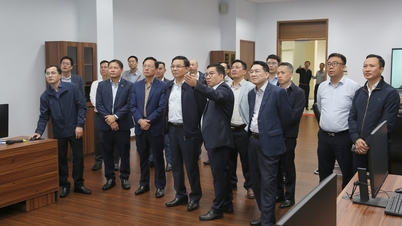The National Assembly also requires credit control in potentially risky areas; effective management of real estate, the stock market, etc.
This is not the first time that the request to direct capital flows to priority sectors, control credit risks, and effectively manage the real estate market has been put forward in a resolution of the National Assembly. In the context of credit facing high growth pressure to support double-digit growth, this request is even more urgent.
Along with the credit growth target in 2026, it is likely that 3.5-4 million billion VND will be pumped into the economy . However, the risk to the economy will be very high once this capital flow goes astray.
Lessons from China show that when the ratio of real estate credit to total outstanding debt reaches 50%, the risk of collapse is unpredictable. In Vietnam, the official statistics given by the State Bank is more than 20%, but experts say that if the total outstanding consumer credit is included, the real figure is over 30%.
If credit continues to expand in the coming years, while there is a lack of effective credit risk control mechanisms and capital continues to flow into real estate, this ratio will soon increase to 40%. At that time, controlling the risk spread will become more difficult.
According to the financial reports of the third quarter of 2025 of many banks, outstanding loans for real estate business account for about 1/3 of total outstanding loans. If including consumer loans, the proportion is much higher.
Although the Government 's desire is to direct capital flow into production and business, it is easy to see that a significant amount of capital is flowing into speculation, especially real estate speculation.
The fact that real estate credit is “circling” between banks and investors in the form of banks lending to investors to build houses, then lending to buyers to buy the same product, and then investors continue to use the proceeds to open new projects, also contains many potential risks. In other words, the risks of the real estate market are naturally transmitted to the banking system.
Thus, if there is no effective mechanism to control capital flows, these risks will become apparent in the next few years, when the ratio of real estate credit/GDP becomes larger and larger. That relationship also prevents housing prices from decreasing, despite all the efforts of the Government.
Currently, the Ministry of Construction is presiding over and coordinating with relevant agencies to propose to the Government to implement a number of solutions such as building and managing an information system and database on housing and real estate market to serve as a basis for building and operating a national database on housing and real estate market; researching and proposing mechanisms and policies to pilot the model of the Real Estate Transaction Center and Land Use Rights; perfecting the legal framework and procedures to establish the National Housing Fund; building and submitting to the Government for promulgation a Resolution on the mechanism to control and restrain real estate prices...
Up to now, while the mechanisms for controlling real estate prices have reached a high consensus, the solution to control real estate credit is still controversial. Many opinions believe that controlling real estate credit is necessary, but it is necessary to avoid interfering too deeply in the business activities of banks, and at the same time, it is necessary to balance between controlling risks and supporting growth. The most important thing to prevent credit from flowing into real estate is to promote the investment and business environment, expand the market, stimulate consumption... thereby stimulating capital flow into the production sector.
For the real estate sector alone, the immediate solution to control this credit flow is to expand other capital mobilization channels for businesses, especially bonds, stocks, crypto assets, etc. Next, is to increase the supply of housing for low- and middle-income people. Particularly, efforts to make transactions transparent and form a synchronous policy system on land, investment, planning, credit, taxes, etc. are considered vital solutions, contributing to stabilizing the real estate market.
The synchronous implementation of the above solutions not only helps credit flow go in the right direction, but also prevents risks from the real estate market from being transmitted to the banking sector.
Source: https://baodautu.vn/ngan-rui-ro-tu-tin-dung-bat-dong-san-d435555.html











































































































Comment (0)